|
|
Swynford

|
|
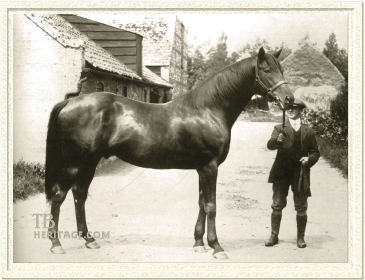 |
|
|
St. Leger winner Swynford was one of two great stallion sons produced by Lord Derby's foundation mare Canterbury Pilgrim. One of the best stayers of his era, Swynford survived a horrific training injury to become a top sire of classic winners, and his many successful stallion sons attested to his prepotency at stud. His male line continues today mainly through his son Blandford and descendants Vieux Manoir, Crepello, Bustino, The Axe II, and Quadrangle.
Swynford was the seventh foal out of his dam, Canterbury Pilgrim, a mare which Lord Derby had acquired as a yearling when rebuilding his family's stud at Knowsley, Lincolnshire. Canterbury Pilgrim rewarded her new owner with victory in the Oaks and Park Hill Stakes at three in 1896, proving herself the best staying filly of her crop. Retired to stud, her second foal was the useful stakes winner and later leading sire Chaucer (1900 by St. Simon), who became the head of the Derby stud until Swynford replaced him.
|
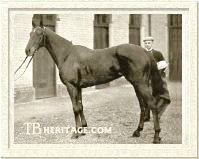
His dam, Canterbury Pilgrim
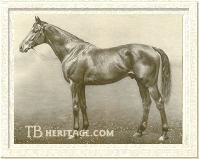
His sire, John o' Gaunt
| |
Swynford was conceived during a barren year for Canterbury Pilgrim, as Chaucer had been. She was one of the first mares covered by John O'Gaunt in his first season at Blink Bonny Stud in Yorkshire in 1906. Bred by the famed Sledmere Stud, John O'Gaunt was blessed with a matchless pedigree, being by the great runner and sire Isinglass, and out of the brilliant racemare La Fleche, but inherited his father's bad foreleg unsoundness. Winner of the Hurstbourne Stakes at two, his only career victory, John O'Gaunt was unlucky not to win at three, although his placings included seconds in the 2,000 Guineas and Derby Stakes, both to St. Amant.
John O'Gaunt's stud career started off with great promise, with the likes of Swynford in his first crop, and 1,000 Guineas winner Kennymore a few years later. Unfortunately, he sired little of class after that, and other than his dramatic influence through Swynford, his only other legacies are few. One is through his non-winning son Harry of Hereford (a full brother to Swynford), who sired Annette K., who, when sent to America, became the granddam of War Admiral. John O'Gaunt's daughter, Mandy Hamilton, was also sent to the U.S., where she produced the good runner and sire Supremus.
|
Swynford was bred by the sixteenth Earl of Derby and was foaled in January of 1907. He was a three-quarter brother to the ill-fated Glasconbury, who had been by John O'Gaunt's sire Isinglass. Being sound to the extreme, Canterbury Pilgrim was the ideal mate for the unsound, bad-legged John O'Gaunt. Oddly, though Swynford bore little resemblance to his diminutive dam, Canterbury Pilgrim, his training record mirrored hers to a remarkable degree.
Lord Derby died in June of 1908 and his son, the former Lord Stanley, became the seventeenth Earl of Derby. He inherited the title as well as his father's stud and the racing stable, which was trained by George Lambton at the newly built Stanley House Stables in Newmarket (which replaced the stable's former home at adjacent Bedford Lodge). A big, strapping brown colt, Swynford came into Lambton's hands as a rough-edged yearling straight from the fields. Lambton noted that the "magnificent" foal he had seen the year before had grown "into a great, plain, rather flat-sided colt, but he had a big, lean, game head, good legs and feet, and when he chose to extend himself he was a fine galloper."
Swynford on the Turf
Swynford's first work came in July of 1908, when tried with an older sprinter named Well Done, who the younger colt dusted rather quickly, carrying equal weight. But no matter how well Lambton thought of the colt in the morning works, Swynford had other ideas. For starters, not unlike his dam, he pulled like a steam engine. In his turf debut in the six furlong Exeter Stakes at Newmarket that same month, he bolted out of jockey Maher's control from the start, exhausted himself, and finished unplaced. Shortly after this, Swynford developed a thoroughpin and was kept from racing for the rest of the season.
Thriving as an individual, although training unimpressively, Swynford debuted at three in the Derby Stakes, but ran poorly in a race won by Lemberg, who would become his arch-rival. It was discovered that Swynford been struck in the running, and came home with a nasty-looking scrape from ankle to hock that healed without incident. He started next in the one mile St. James's Palace Stakes at Royal Ascot but finished an uninspiring third.
A few days later Lambton sent him out for the twelve furlong Hardwicke Stakes, knowing that the colt, like his dam, had the stamina to gallop all day. Swynford, still being a maiden, got the generous end of the weights and won, but barely. Then, in a work against the Ascot Derby winner Decision, Swynford beat his stablemate decisively. Lambton's big, ugly duckling had become a swan.
In the Liverpool Cup, he dragged jockey Frank Wootton to the front and led every step of the way to win with ease. In the St. Leger, he led from start to finish, beating Bronzino and Lemberg. In the Liverpool St. Leger, no one took the course against him and he walked over for the victory.
At four, Swynford won the Chippenham Plate (twelve furlongs, Newmarket) and in a rematch with Lemberg in the Coronation Cup over the same distance at Royal Ascot, lost to that colt when using a stalking tactic instead of setting the pace as usual. He turned the tables on Lemberg, in the Princess of Wales's Stakes (twelve furlongs, Newmarket) going to the front and never looking back, and won again in the ten furlongs Eclipse Stakes with the same tactics. Then, training for the Jockey Club Stakes in September, Swynford took a bad step while galloping at half speed on the Newmarket July Course.
Lambton remembered the incident with singular detail. "There were only two horses in the gallop, and they had to pass a haystack, which hid them from view for a moment or two. I watched them go behind it and then only one horse came on. I galloped straight down, and found Swynford standing on three legs. It was an hour and a half before we could get Mr. Livock, the veterinary surgeon, and an ambulance, and then it was nearly an hour before we could get the horse into it. The task of getting such a great big horse out of it on three legs seemed impossible, and it was a wonderful piece of work on the part of Mr. Livock to accomplish it. Personally I have never spent a worse day in my life."
Swynford's injury was serious, having destroyed a front fetlock joint, and under normal circumstances, the patient would have been destroyed, but all efforts were made to save him, and miraculously succeeded, due in large part to Livock's ability and Swynford's good temperament. Since Lambton considered Swynford the best horse he ever trained, the breakdown was even more the tragedy to him.
Swynford in the Stud
Swynford entered stud at Woodlands in 1913 and proved a tremendous success from the start. He was an even better sire than Chaucer, and quickly earned the better mares, although like his brother, his fillies tended to be better than his colts. His offspring were generally big and powerful, even the fillies (Keysoe was 16.3 hands tall), and like their sire and his family, they preferred the longer distances. He sired six classic winners, all but one of which were fillies, scoring in eight classics - four winners of the 1,000 Guineas (Ferry, Bettina, Tranquil, Saucy Sue), one winner of the Oaks (Saucy Sue), one winner of the Derby (Sansovino), and two winners of the St. Leger (Keysoe, Tranquil). Swynford was the Leading Sire in Tranquil's year, 1923.
Although not winners of the classics, his two best racing sons were Blandford and Challenger II, with his Derby-winning colt Sansovino ranking behind them.
|
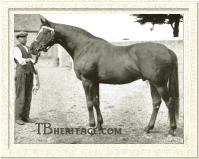
Blandford
| |
Bred by the National Stud at Tully, in Ireland, BLANDFORD (b.c. 1919 out of Blanche by White Eagle) inherited his grandfather John O'Gaunt's bad forelegs. He was particularly short and upright in his pasterns, and sold for just 730 guineas at the December Sales as a yearling to Sam and Richard Dawson of Whatcombe. He made only 2 starts at 2, winning his debut, and second by a neck in the Windsor Castle Stakes at Ascot to Alaric. He was one of the top ranked colts, and returned at three to show he justified that high ranking. In his first race at three, he won the mile and a quarter Paradise Stakes, then won the Princess of Wales's Stakes over twelve furlongs at Newmarket but his career was over that July after he bowed in both front legs, a result of his poor conformation. |
|
Although lacking somewhat in sperm count and libido, Blandford proved an even more important sire than Swynford, becoming the Leading Sire three times (1934, 1935, 1938). His offspring included four Derby winners -- Trigo, Blenheim II, Windsor Lad, Bahram -- and of those, Blenheim II was the only one not to win the St. Leger as well. Bahram also won the 2,000 Guineas, scoring a Triple Crown in 1935. Blandford's other classic winners included Pasch (2,000 Guineas), Udaipur (Oaks), Campanula (1,000 Guineas), and the great French champion BrantŮme.
|
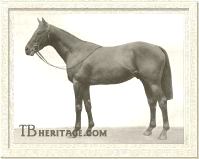
Challenger II
| |
Swynford's other top class son, CHALLENGER II (b.c. 1927 out of Sword Play by Great Sport) was also bred by the National Stud at Tully, and was sold to Lord Dewar for 5,000 guineas. He was undefeated in two starts at two, the Richmond Stakes (in his debut) and Clearwell Stakes. He was third highweight that season with 127 pounds behind Diolite and Press Gang. Lord Dewar died when Challenger was still a two-year-old, making his classic engagements null and void, so the colt was offered for sale. He did not start as a three-year-old, and was purchased for 10,000 pounds by Americans William L. Brann and Robert S. Castle.
|
|
Challenger sustained a hock injury, tangled in barbwire while waiting to be sold, and once he healed, he was shipped to America. He started eight times in California but showed nothing, and was retired to stud at Brann Castle Farm, later renamed Glade Valley Farm in Maryland. There he sired champions Challedon, Gallorette, and Bridal Flower, and other good ones in Errard, Vincentive, Pictor, Challenge Me, and broodmares Legendra, Savage Beauty, and Gallita. Challenger II was the Leading Sire in the U.S. in Challedon's year, 1939. |
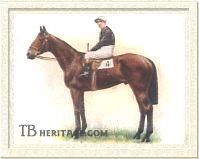
Sansovino
| |
Swynford's good colt SANSOVINO (b.c. 1921 out of Gondolette by Loved One) was the homebred offspring of a mare who had been specifically purchased by Lord Derby to breed to the brothers Chaucer and Swynford. Gondolette's sire, Loved One (also the sire of the dam of Great Sport, in Challenger II's pedigree), was a half-brother to their dam, Canterbury Pilgrim, and Gondolette's granddam, Douranee, was by Rosicrucian, a full brother to The Palmer, sire of Pilgrimage (dam of Loved One and Canterbury Pilgrim). Sansovino's pedigree was intense: 3x3 to Pilgrimage and 4x4x4 to the brothers The Palmer (twice) and Rosicrucian. Gondolette produced nothing of note by Chaucer, then produced Swynford's 1,000 Guineas-winning daughter Ferry in 1915, a nice filly in 1913 by Minoru named Serenissima (dam of Chaucer's great daughter Selene), then Sansovino in 1921.
|
|
A big, strong, rough and tumble colt like his sire, Sansovino won the Ham Produce and Gimcrack Stakes at two, and at three won the Derby Stakes and Princess of Wales's Stakes. His six-length victory in the Derby was in a driving rainstorm on a very heavy course which favored few of the runners. Sansovino romped in the muck, beating St. Germans (also by Swynford) home, although a substandard Derby winner by anyone's accounting. At four, he won the Lingfield Park Spring Stakes and was second in St. German's Coronation Cup before breaking down in the Jockey Club Cup, his final start. At stud, Sansovino was a disappointment, but still useful, siring St. Leger winner Sandwich (also winner of the Chester Vase, King Edward VII Stakes, and walked over for The Whip at four), also Sansonnet (champion two-year-old in 1935; dam of Tudor Minstrel), the stayer Buckleigh (Newmarket St. Leger, Craven Stakes at three, Doncaster Cup at four, Jockey Club Cup at five, and Manchester Cup at six), Jacopo (Molecomb, Windsor Castle, Princess of Wales's Stakes; sire in U.S.), and the cup horse St. Magnus (dam's sire of Australian Matrice). |
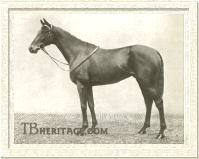
St. Germans
| |
ST. GERMANS (br.c. 1921 out of Hamoaze by Torpoint) was bred by Viscount Astor at Cliveden Stud. He was a really top class stayer and probably better than Sansovino, who beat him in the Derby. Prior to the Derby he won the Craven Stakes, and later scored in the Lowther Stakes, Royal Post Stakes, Limekiln Stakes, Liverpool St. Leger, and Hampton Court Great 3YO Stakes (beating Straitlace) at three. At four, he won the Burwell Stakes, Coronation Cup (beating Sansovino by six lengths), and Doncaster Cup. With his older half-brother Buchan (by Sunstar) already at stud at Cliveden, St. Germans, was sold to American John Hay Whitney and entered stud in Kentucky where he was a tremendous success, even despite his marked infertility.
|
St. Germans was America's Leading Sire in 1931, the year his son Twenty Grand was the champion and winner of the Kentucky Derby and Belmont Stakes. Unfortunately, Twenty Grand proved sterile, but St. Germans' son Bold Venture won the Kentucky Derby and Preakness, and went on to sire Triple Crown winner Assault and Derby/Belmont winner Middleground. St. German's also sired the champion handicapper Devil Diver, and stakes winners The Rhymer (sire of Vertex), St. Brideaux, The Darb, Piquet (dam of Capot), and Sparta.
Swynford got another good stayer in SILURIAN (br.c. 1919 out of Glacier by St. Simon), winner of the Doncaster Cup, Queen's Handicap, and second in the Ascot Gold Cup (by a head to Happy Man). A half-brother to Oaks winner Toboggan, Silurian was sent to stud in Argentina, where he led the sires' list three times, in 1930, 1931, and 1934, when his son El Pelado dominated racing. He also sired Black Arrow, Silfo, and the mare Spitfire (third dam of Practicante).
Swynford's other good colts included the useful but unsound HAINAULT (1914 out of Bromus by Sainfoin), a Derby-bred half-brother to Phalaris and one of Swynford's first good runners, from his first crop. Hainault went to stud in Ireland and there sired Irish classic winners Haine, Amethystine, and Haintonette.
LANCEGAYE (b.c. 1923 out of Flying Spear by Spearmint), half brother to Sparus, won the Hardwicke Stakes and Great Northern St. Leger. As a sire in England, he covered the Hurry On mare Hastily, who was sent to America to foal. The colt she was carrying was champion Cavalcade, whose success prompted the importation of Lancegaye, although he sired only one other stakes winners, War Lance after his arrival and was a failure otherwise, as was Challedon. Lancegaye's English daughter, Styrian Steel, was the granddam of the mare L-S-D, and fourth dam of Saulingo.
Swynford's son UNDER FIRE (b.c. 1916 out of Startling by Laveno) was imported to race in the U.S., where he was a stakes winner and third in the Kentucky Derby. As a sire, he got Bagenbaggge and Dugout. The latter is his true claim to fame, since she is the fourth dam of the great sire Bold Ruler. SWIFT AND SURE (b.c. 1923 out of Good and Gay by Bayardo) won the Chester Vase and Duchess of York Stakes. Sent to stud in America, he sired 14 stakes winners, although nothing outstanding, although his daughters were good broodmares, producing Education and Dispose. BIRTHRIGHT (dk.b. or br. 1924 out of Lineage by Tracery) won the Woodcote Stakes and Fitzwilliam Stakes. His daughter Justitia is the granddam of Rambunctious.
Swynford's lesser sons include the well-bred plater SCHIAVONI (brother to Tranquil and sire of the mare Schiaparelli), ROYAL FORD (sire of Heelfly, who was dam's sire of T.V. Lark), STRATFORD (a good sire of two-year-olds), SWINBURNE, and ILIAD. |
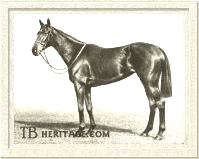
Tranquil
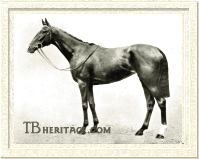
Saucy Sue
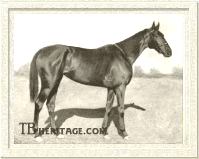
Keysoe
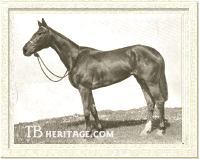
Ferry
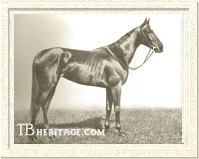
Bettina
| |
Swynford's daughters were a strong lot, although generally better runners than broodmares. The best might have been regally-bred TRANQUIL (b.f. 1920 out of Serenissima by Minoru). Bred by Lord Derby, she was a half-sister to Selene (by Swynford's half-brother Chaucer), Bosworth, and a full sister to the plater Schiavoni. At three in 1923, she won the 1,000 Guineas, St. Leger (beating Papyrus and Teresina), Newmarket Oaks, Jockey Club Cup, and Liverpool St. Leger.
Tranquil was not a good broodmare, however. Her daughter Nevada (1929 by Colorado) is primarily remembered as the dam of the stallion Sierra Nevada (1936 by Gainsborough), who was imported to stand in California and sired a few stakes winners there.
SAUCY SUE (b.f. 1922 out of Good and Gay by Bayardo), bred and owned by Viscount Astor, was a full sister to stakes winners Swift and Sure and Bold and Bad. Champion of her sex at two, at three she won the 1,000 Guineas (by six lengths) and Oaks (by eight lengths). That year, she also won the Coronation Stakes (Royal Ascot) and Atalanta Stakes. She retired with the admirable record of eight wins in ten starts.
As a broodmare, Saucy Sue was short-lived and produced only a few foals. Her singular winner was Truculent (c. 1928 by Teddy), winner of the Royal Standard Stakes. Truculent was a good sire but died young. His best was Flag of Truce (1934 ), who got Respite, dam of 2,000 Guineas winner Nearula. His son Two Ton Tony was a sire in Australia. His daughter Carresante, produced the good American filly Special Touch. Another daughter, Truckle, produced the brilliant sprinter and California sire Fair Truckle.
Lord Derby's KEYSOE (br.f. 1916 out of Keystone II by Persimmon) was a sister to Northumberland Cup winner Trestle and half-sister to Archaic, (a sire of steeplechasers in America). She stood 16.3 hands and was unraced at two. At three, Keysoe won the St. Leger, Gratwicke Stakes, Nassau Stakes, and Newmarket Oaks.
Keysoe produced the good stayer Caissot (1923 by Gay Crusader), winner of the Newmarket St. Leger, Liverpool St.Leger, and Prince of Wales's S. Caissot became an important sire in Hungary, getting Intermezzo, City, and Puczur. His son Intermezzo was a very successful sire in Central Europe. Keysoe also foaled the filly Flittermere (1926 by Buchan), whose daughter Indian Call (by Solario) produced the outstanding Irish colt Ballymoss. Keysoe's son Papworth (1929 by Papyrus) was imported and sired six stakes winners from 70 foals in California.
Sansovino's sister FERRY (b.f. 1915 out of Gondolette by Loved One) won the 1,000 Guineas and was second in the Oaks, but was not a good producer for the Derby stud. Her daughter Mayflower (1922 by Gay Crusader) was sent to Argentina where she produced May Rose (1931 by Macon), dam of the important broodmare Margarita (1942 by Full Sail), whose offspring Mangana and Mamboreta, both by Gulf Stream, were major winners in Argentina.
|
BETTINA (b.f. 1918 out of Bobbina by Desmond), bred and owned by Walter Raphael, was a stakes winner at two and won the 1,000 Guineas at 33/1 odds at three. She produced nothing of note and died young.
Swynford's other good racing daughters included Yorkshire Oaks winner BLUE ICE, also ROSEOLA (dam of Tornado, Astrologer), and Keysoe's sister TRESTLE.
His better producing daughters were his lesser-talented ones. The best of these were DRIFT (dam of Heliopolis, Sun Stream, Tide-Way, Fairhaven), SWEET LAVENDER (dam of Lavendula, Kalmia, Fragrance), ROSE RED (dam of Aurora), SARITA (dam of Sister Sarah, Sabzy), TOURAINE (dam of Tourist II), VALESCURE (dam of The Bastard/The Buzzard), HARPY (dam of Orpen and Irish Derby winner Raeburn), VICTORY (dam of Victrix), and the inbred VIRGIN'S FOLLY (dam of Thoughtless, granddam of Star Kingdom).
Swynford died at Woodlands Stud, Newmarket, in the middle of the breeding season, on May 18, 1928 at the age of 21. He had survived his brother Chaucer by two years, the latter having died in 1926 at the age of 26.
-- Anne Peters
|
|
|
|

